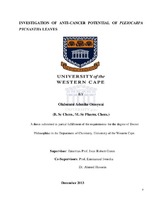| dc.description.abstract | The Apocynaceae family is well known for its potential anticancer activity. Pleiocarpamine isolated from the Apocynaceae family and a constituent of Pleiocarpa pycnantha has been reported for anti-cancer activity. Prompted by a general growing interest in the pharmacology of Apocynaceae species, most importantly their anticancer potential together with the fact that there is scanty literature on the pharmacology of P. pycnantha, we explored the anticancer potential of the ethanolic extract of P. pycnantha leaves and constituents. Three known triterpenoids, ursolic acid C1, 27-E and 27-Z p-coumaric esters of ursolic acid C2, C3 together with a new triterpene 2,3-seco-taraxer-14-en-2,3-lactone (pycanocarpine C5) were isolated from an ethanolic extract of P. pycnantha leaves. The structure of C5 was unambiguously assigned using NMR, HREIMS and X-ray crystallography. The cytotoxic activities of the compounds were evaluated against HeLa, MCF-7, KMST-6 and HT-29 cells using the WST-1 assay. Ursolic acid C1 displayed potent cytotoxic activity against HeLa, HT-29 and MCF-7 cells with IC50 values of 5.06, 5.12 and 9.51 μg/ml respectively. The new compound C5 and its hydrolysed open-chain derivative C6 were selectively cytotoxic to the breast cancer cell line, MCF-7 with IC50 values 10.99 and 5.46 μg/ml respectively. We further investigated the mechanism of action of the isolated compounds using specific markers of apoptosis. Exposure of C1-C6 (12.5 μg/ml) to HeLa cells showed a significant increase in reactive oxygen species (ROS) production with the exception of C5. On HT-29, C1, C4, C5 and C6 at 25 μg/ml increased ROS production while on MCF-7 using the same dose, only C5 and C6 caused a significant increase in ROS production compared with a control at P< 0.05. The result on caspase 3/7 activation showed that C1 and C2 (50 μg/ml) caused a marked increase in caspase 3/7 activity between 6-24 h on HeLa cells while only C1 (50 μg/ml) showed a significant increased caspase 3/7 activity on both HT-29 and MCF-7 cell lines when compared with the control, P< 0.05. Some selected compounds were further investigated for their dose-response on caspase 3/7 activity on HeLa and MCF-7 cells. Compounds C2 and C3 activated caspase 3/7 at 12.5 and 25 μg/ml respectively, while on MCF-7only C6 significantly increased caspase 3/7 activity within 24 h of treatment when compared with an untreated control. The result of time -dependent caspase 9 activity showed that C1, C2 and C3 caused an increased activity on HeLa cells between 6-12 h, while only C1 activated caspase 9 on HT-29 cells (3-24 h) and MCF-7 (6-24 h). The dose-response caspase 9 activity showed a significant increase in activation for C6 (12 and 25 μg/ml) on HeLa and C5 (25 μg/ml) on HT-29 cells. All isolated compounds inhibited Topoisomerase I when compared with Camptothecin. Compounds C1-C6 could induce apoptosis on cancer cell lines through an intrinsic pathway and topoisomerase 1 inhibition. This is the first report on the isolation of a 2,3-seco-taraxerene derivative from Apocynaceae family and the anticancer activity of Pleiocarpa pycnantha constituents. | en_US |

